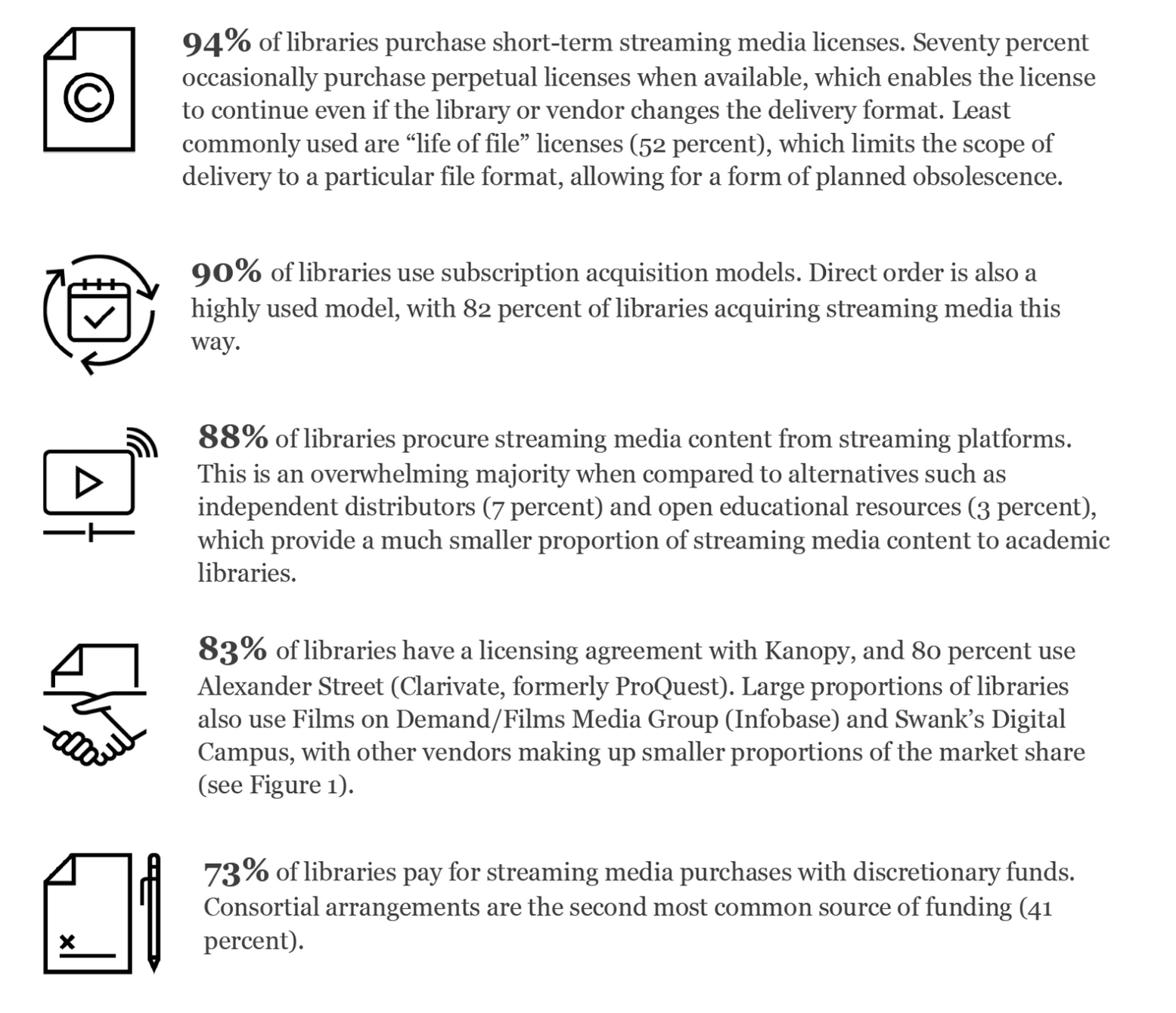Streaming Media Licensing and Purchasing Practices at Academic Libraries
Survey Results
Introduction
University instructors and students have a huge appetite for streaming media, and demand is growing apace as the format achieves mainstream market dominance over earlier technologies such as DVDs. University libraries purchase and license the bulk of this content intended for campus-wide (as opposed to personal) consumption and are facing numerous challenges associated with integrating streaming media into their collecting strategies. Pricing models can make it difficult to fully meet patron demands, and some collections feature content that is not consistent with the library’s mission.[1] To compound matters further, streaming media businesses focused on providing educational content are rapidly evolving due to mergers and acquisitions and the development of new business models among the sector’s dominant companies.
As the urgency of these issues has grown, researchers have undertaken several important efforts to track how libraries are approaching the streaming media market and troubleshoot the challenges they are encountering, focusing especially on strategies for balancing patron demand with managing costs.[2] Building on those data gathering efforts, this report shares findings from the most comprehensive survey to date of academic library streaming media approaches at four-year institutions in the US and Canada. The survey was conducted as part of a unique partnership between Ithaka S+R and 24 academic libraries that are collaborating to explore how to advance streaming media strategy in libraries (see Appendix I).
In 2021, Ithaka S+R conducted a survey designed to provide insight into the streaming media strategies libraries are adopting and the challenges they are facing. The survey tracked the vendors libraries are most commonly working with, acquisition models and licensing agreements, current and projected budgets for streaming, and the digitization of physical media. Our key findings provide essential insight into how libraries’ streaming media strategies are evolving:
- The impact on instruction is the top factor driving academic library decision-making related to purchasing and renewing streaming licenses.
- Streaming media is a growing segment of the library materials budget, with its footprint projected to double over the next five years.
- Digitizing VHS tapes and DVDs is happening at a much smaller scale relative to libraries’ purchasing and licensing approaches to addressing streaming media demands.
- Libraries in Canada and the US are taking a fairly similar approach in their streaming media strategies, with a major exception being the extent to which their strategies evolved in response to the pandemic.
The library’s emphasis on meeting instructional needs when purchasing and licensing streaming media content necessitates a strong alignment with the university’s pedagogical goals. Our report concludes with reflections for both libraries and streaming media providers as they navigate the teaching and learning opportunities presented by the streaming format. These conclusions lay the groundwork for forthcoming findings from qualitative research conducted in parallel to the survey results presented here, which involved interviews with instructors from the 24 universities that partnered with Ithaka S+R on this project. The aggregate findings from those interviews will be published later this year.
Creating the Survey
We developed the survey after carefully reviewing prior studies focused on sector-wide trends related to streaming media to ensure that the instruments built on prior efforts. We also consulted with library stakeholders with expertise in streaming media to test the survey instrument through a cognitive interviewing process. Those who provided their guidance during the survey development process are listed in Appendix 2 and we thank them for their contributions. For more information on the survey methodology, please see Appendix 3.
Streaming Media Licensing Landscape
Though libraries’ management and acquisition of streaming media offerings vary by institution, several strong themes emerged, providing an image of the streaming media licensing landscape at academic libraries in the US. Below we provide notable patterns regarding streaming license agreements and models, vendors, and funding.
A major theme in the academic streaming context is market dominance. Kanopy and Alexander Street dominate the market with 83 and 80 percent of libraries using them respectively (see Figure 1).[3] Films on Demand/Films Media Group (Infobase), Swank’s Digital Campus, and Naxos are also used by more than half of all libraries. Most libraries use multiple vendors to meet their streaming media needs. While some vendors have broad streaming offerings, others have media specific to certain fields—for example JoVE in the hard sciences and Digital Theater Plus in the performing arts—that structurally prevent them from dominating the landscape.
Figure 1. Which of the following streaming media providers does your library currently use? Top 15 most commonly used vendors.
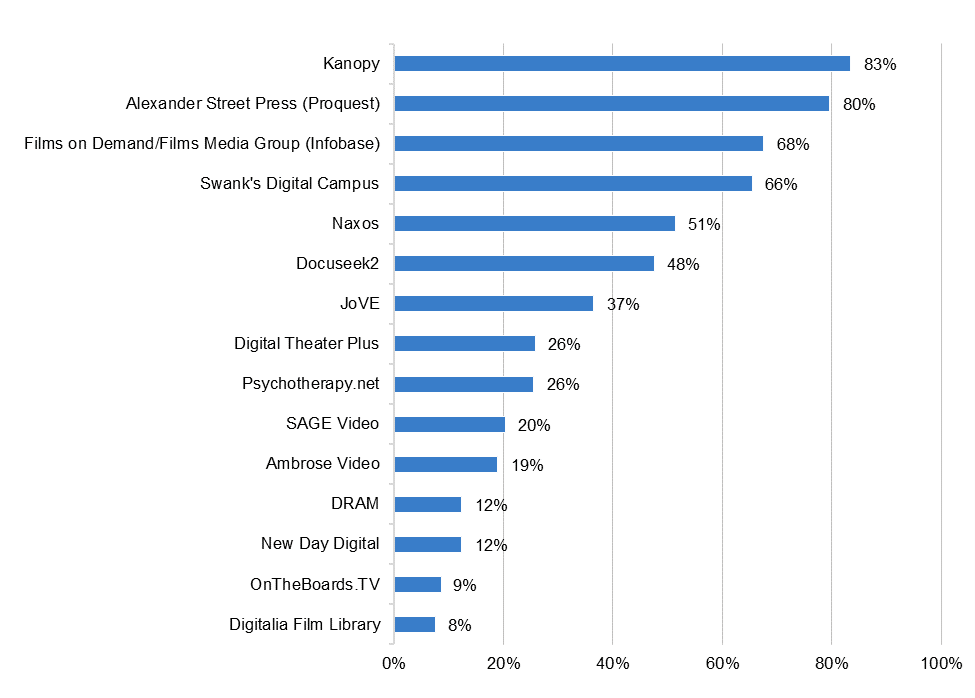
When comparing the two most commonly used streaming media providers, nearly a third more librarians are satisfied with Kanopy’s audio/video quality than with Alexander Street’s (see Figure 2). And librarians are considerably more satisfied with Kanopy’s user-friendliness for both students and faculty. Conversely, nearly three times as many librarians are satisfied with the price point of Alexander Street compared to Kanopy and are also more likely to be satisfied with Alexander Street licensing options.
Figure 2. In regards to Kanopy or Alexander Street Press (ProQuest), to what extent are you satisfied or dissatisfied with each of the following? Percentage of respondents that are satisfied with each item.
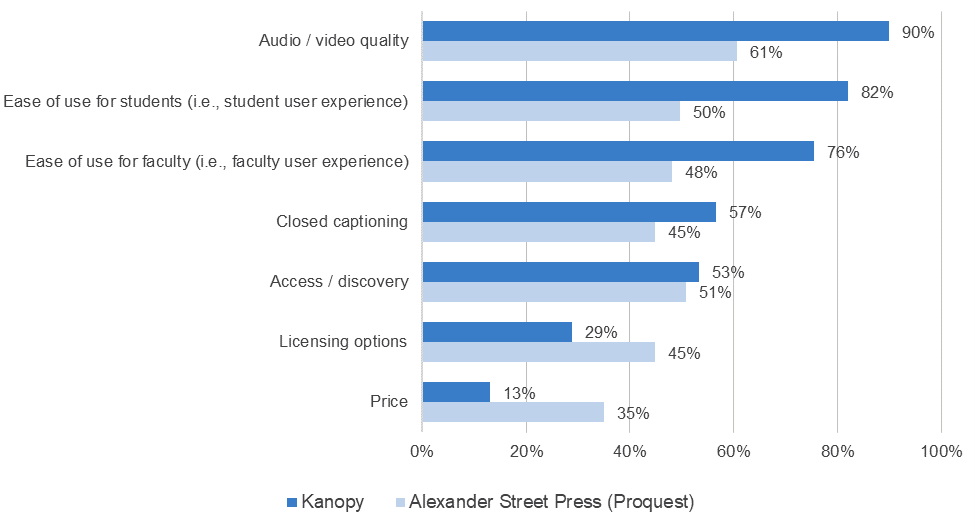
Within the library, decisions around streaming media purchasing and licensing are often the responsibility of multiple individuals. Only 28 percent of institutions rely on a single individual to make these decisions, while 72 percent share this responsibility between two or more roles. Library collection officers are the most likely to be responsible for these decisions (53 percent), while library faculty (including but not limited to subject/liaison librarians) are a close second (48 percent) (see Figure 3).
Figure 3. Who has the primary responsibility for making decisions on what streaming media materials are purchased or licensed? Please select all that apply.
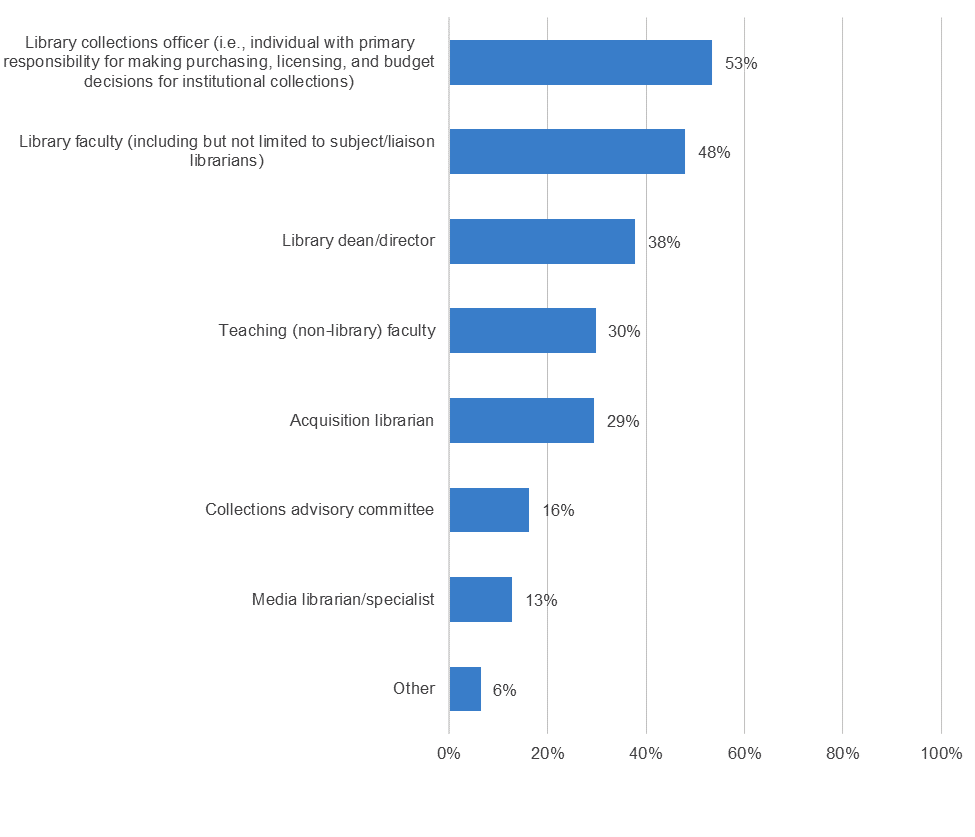
Impact on instruction is the number one factor shaping academic library decision-making in purchasing and renewing streaming licenses.
A variety of factors influence librarian decision-making regarding purchasing or renewing streaming services at their institution. However, the number one factor influencing these decisions, even ahead of cost, is the impact on instruction and support of the curriculum. A staggering 96 percent of librarians said impact on instruction was important in shaping their choices regarding purchasing and renewing streaming media licenses. This nearly unanimous outlook is likely bolstered by the increased role streaming media has played in providing educational resources to students since the start of the pandemic—in fact, two-thirds (67 percent) of librarians say that streaming media has become more important for meeting student needs since March 2020. It is important to recognize that cost and quality were also reported as highly important factors, which suggests that libraries weigh multiple factors when making decisions about what streaming media content to purchase. At the other end of the spectrum, flexible payment models and long-term relationships with content providers were among the least important in influencing librarians’ purchasing and renewing choices (see Figure 4).
Figure 4. How important are the following factors in shaping your decision-making in purchasing and renewing streaming licenses? Percentage of respondents that rated each item as important.
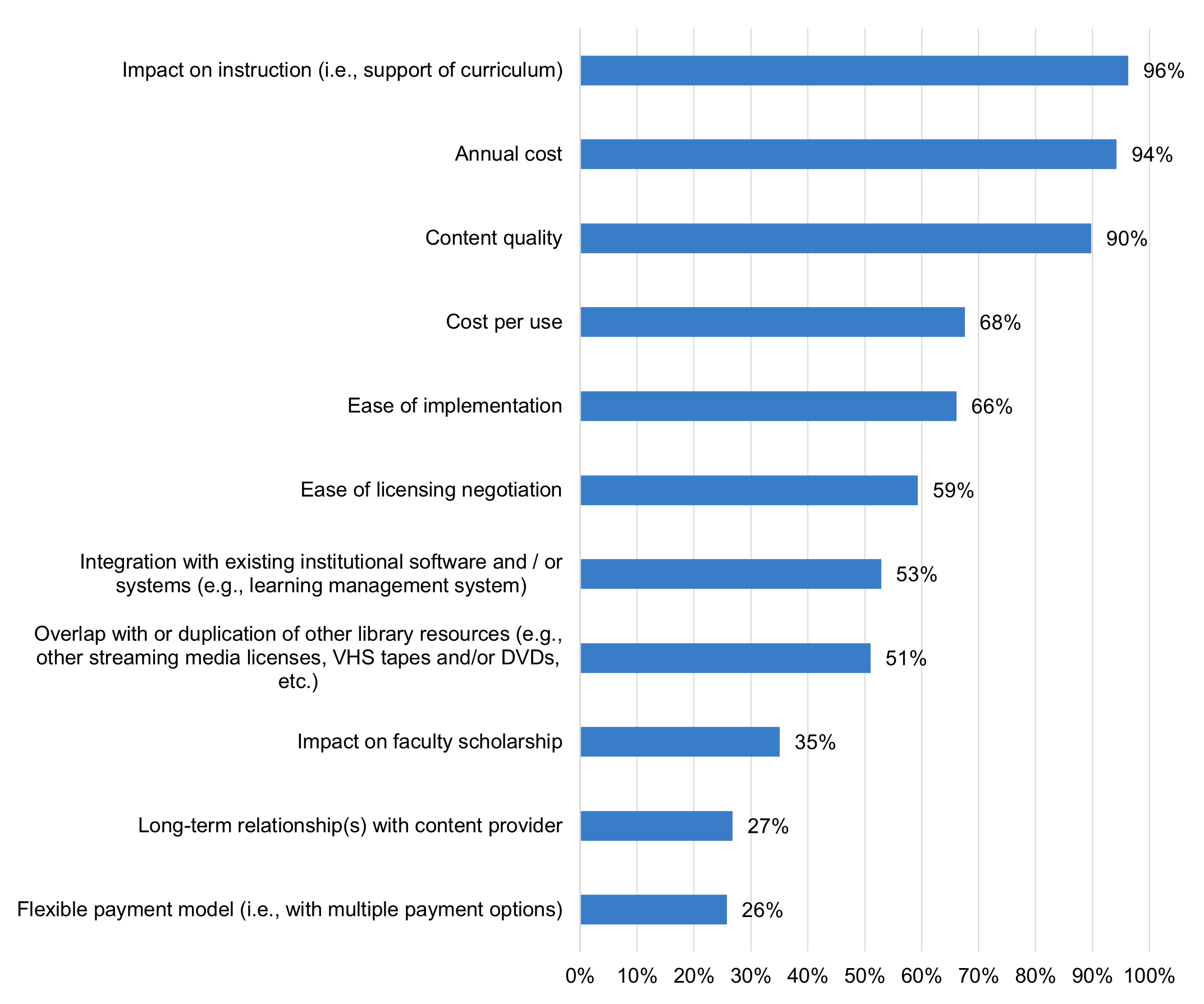
In a similar vein, how libraries make digitized versions of pre-existing VHS tapes and/or DVDs available to faculty and students is consistent with supporting courses and corresponding curriculum. Libraries are more likely to make digitized VHS/DVDs available for a specific use case (70 percent), for example to students enrolled in a specific course, as opposed to making the content available broadly (24 percent). Likewise, libraries are more likely to make a file available for a limited amount of time (46 percent), which may indicate alignment with a particular term, as opposed to an unrestricted length of time (13 percent).
The impact of the pandemic on streaming media, while significant, may be less than initially understood.
There is no doubt that the COVID-19 pandemic has impacted demand for streaming media over the past two plus years. That said, evidence suggests that the pandemic was an accelerator of a trend that was already taking place as opposed to the cause. While 42 percent of respondents strongly agree that demand for streaming media has increased at their institution since March 2020, the story becomes clearer when we look at the data in conjunction with Carnegie Classifications (see Figure 5). Respondents from master’s colleges and universities were significantly less likely to strongly agree that demand for streaming media has increased (29 percent) compared with doctoral (52 percent) and baccalaureate (44 percent) institutions.
Figure 5. Please read the following statement and indicate the extent to which you agree or disagree. Demand for streaming media has increased at my institution since March 2020. Percentage of respondents that selected each option, by Carnegie Classification.
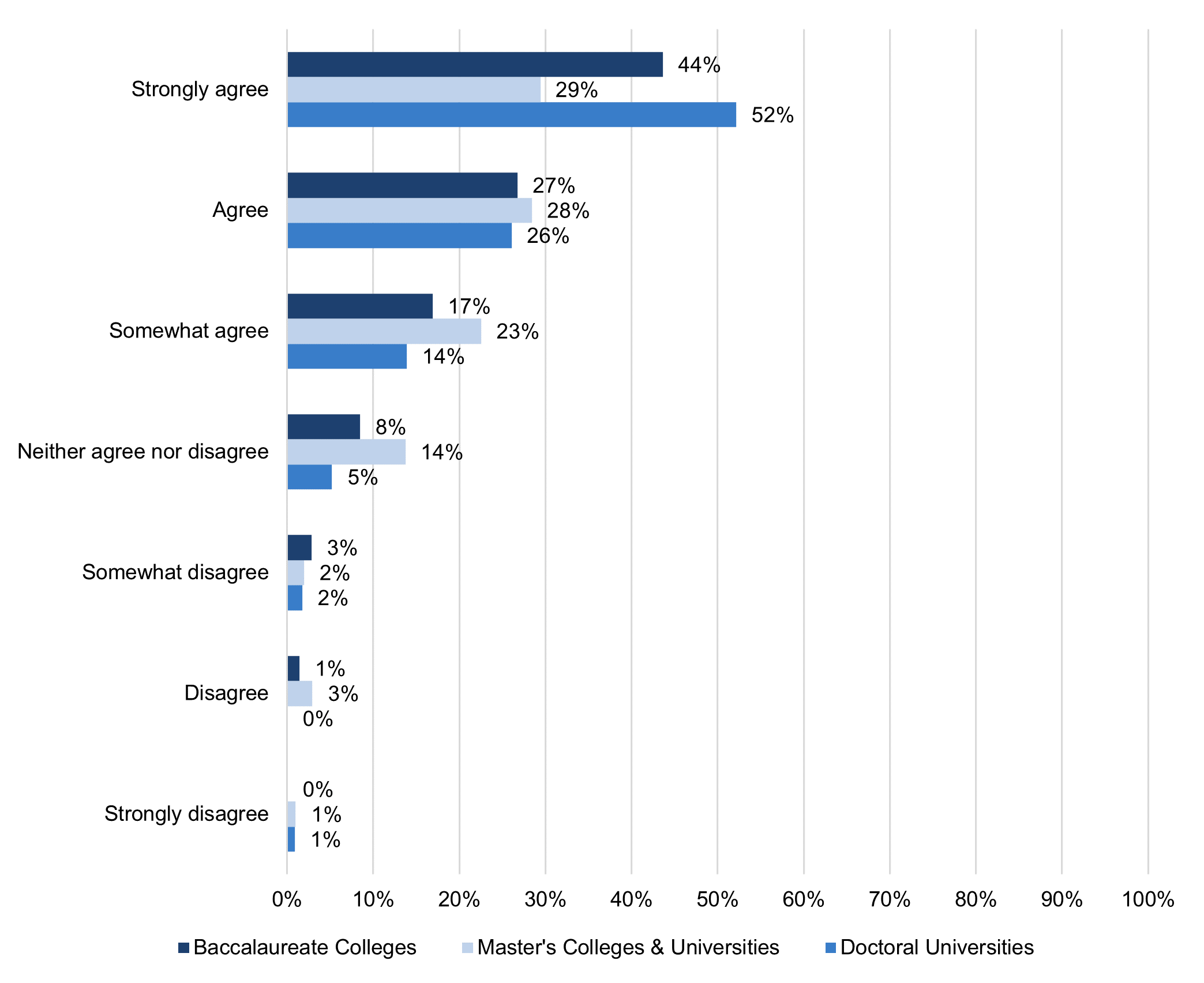
Likewise, librarians at master’s institutions were less likely to strongly agree (13 percent) that their streaming media strategy has changed since March 2020 compared with baccalaureate (35 percent) and doctoral (23 percent) institutions. One possible explanation for this is that master’s colleges and universities may already have had a larger proportion of their student population living off-campus prior to the pandemic compared with other four-year institutions. With more non-residential students and higher levels of remote learning pre-pandemic, COVID-19 did not cause as seismic a shift for these institutions compared with highly residential doctoral and baccalaureate colleges and universities.
Regardless of institution type, it is clear that streaming media licensing strategies have not changed at the same rate that demand has grown since the start of the pandemic. While 42 percent of libraries strongly agree that demand for streaming media has increased, only 23 percent of libraries strongly agree that their library’s streaming media strategy has changed since March 2020. This difference could be explained by a combination of factors; one is that some libraries already had an effective streaming media licensing strategy in place prior to COVID-19. This makes sense particularly for institutions who saw a smaller increase in demand. Another possible explanation is that some libraries, in trying to adapt to the breakneck speed with which the world changed over the past two years, have simply not yet changed their streaming media licensing strategy to match current demand.
Of libraries that have changed their streaming media strategy since March 2020, several themes emerged in regard to what that change looks like. Write-in responses reveal that many libraries increased their investment in streaming services after the start of the pandemic. This appeared to be particularly true for institutions with high proportions of their student populations living on campus. Libraries at residential institutions had been relying on physical media such as VHS tapes and DVDs more heavily and needed to pivot when the pandemic struck. At other institutions, libraries were able to initiate this investment into streaming media after having previously experienced resistance from faculty in years prior. In other words, the pandemic and move to remote instruction illustrated to colleagues outside of the library the importance of investing in streaming, even when the library had already identified this need.
In addition to increased investment, some libraries found their previous models did not scale well with higher demand. There was a shift by some institutions to move away from unmediated acquisition models and move towards mediated acquisitions models, a decision largely driven by cost. Respondents relayed, anecdotally, that these changes were often made in regard to Kanopy’s high prices; unmediated models became unsustainable amid the new height of demand.[4] This helps explain why 59 percent of institutions currently employ a mediated patron-driven acquisition model while only about one-third that many (21 percent) use an unmediated patron-driven acquisition model.
The challenge of meeting the demand for streaming services in a sustainable manner that fits within the scope of a library’s budget is difficult and unlikely to be resolved quickly. Streaming media services were already rising pre-pandemic, and the pandemic created an environment that increased that demand further through the mass shift to remote learning. While many institutions and courses have or will largely return to in-person environments, many colleges and universities will continue to have an online component. All of this to say, the demand for streaming services is unlikely to decrease even after COVID-19 is firmly in the past.
Libraries predict that the proportion of their materials budget dedicated to streaming media will double over the next five years.
In the 2021-22 academic year, two-thirds of libraries spent between one and six percent of their materials budget on streaming media, while about one in ten spent more than 10 percent on streaming media. In five years, libraries predict the proportion of their materials budget spent on streaming media will increase significantly, with more than a quarter of respondents anticipating that they will spend more than 10 percent of their materials budget on streaming services (see Figure 6). Both these figures are consistent with Ithaka S+R’s 2020 library director survey, which found that library directors estimated that streaming would rise from 5 percent to 8 percent of their library’s materials budget by 2025.[5]
Figure 6. In the 2021-2022 academic year, what percentage of your library’s materials budget is spent on streaming media? And, in five years, what percentage of your library’s materials budget do you estimate will be spent on streaming media?
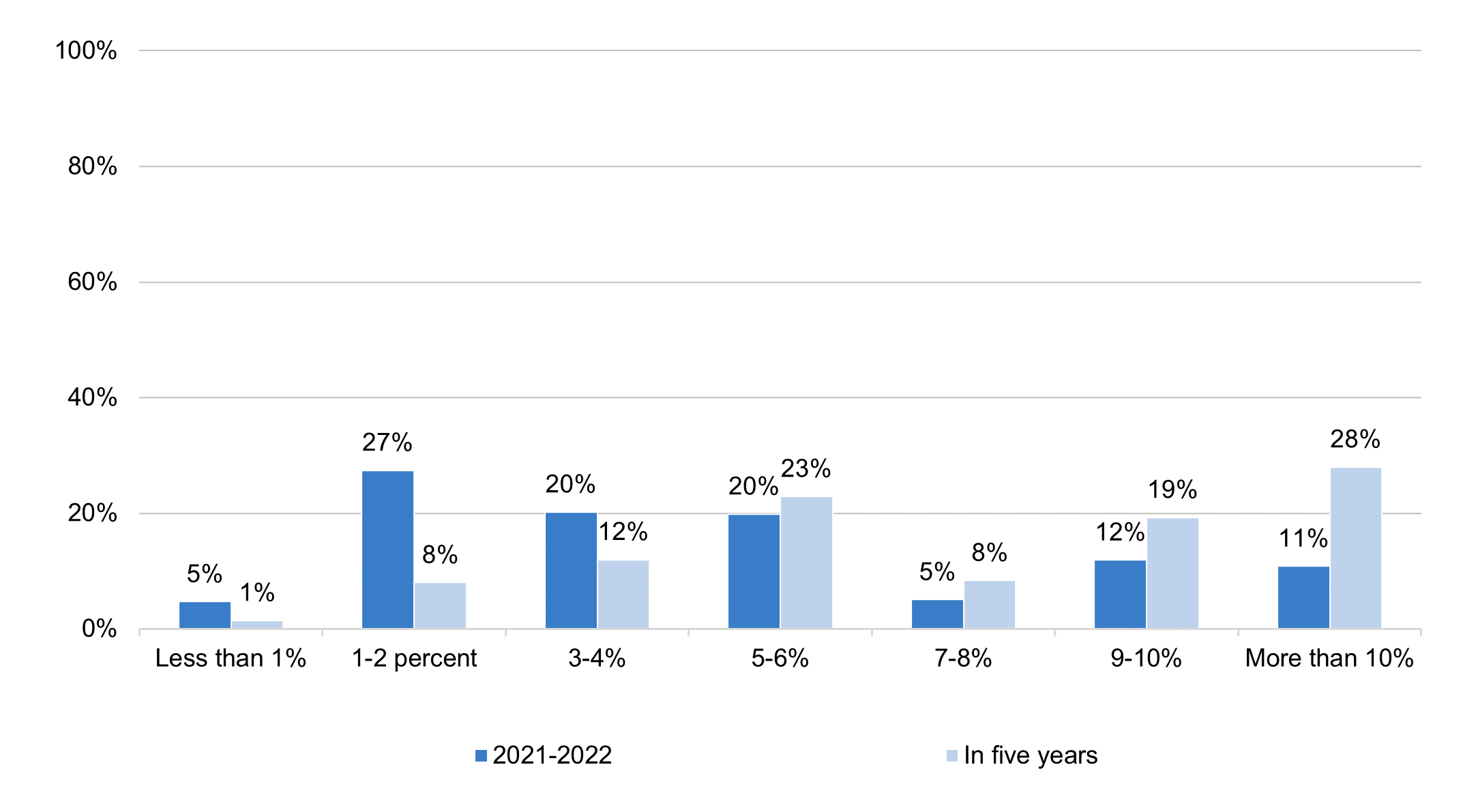
Baccalaureate colleges and master’s colleges and universities currently spend on average 5 and 5.5 percent of their materials budget respectively on streaming media, and both predict this will double to 10 percent in five years. Doctoral universities, which typically have larger materials budgets, dedicated 2 percent of that budget to streaming this past year and predict that it will increase to 5 percent over the next five years.
Importantly, there is some question as to whether the increased proportion of funds dedicated to streaming media will result in increased dollar amounts, or simply a larger slice of the materials budget pie. Since March of 2020, 56 percent of institutions said their budget for streaming media has increased at least somewhat, while 49 percent of institutions said their materials budget decreased over that period of time (see Figure 7). And while, on average, librarians predict their streaming media budget will double over the next five years, only 35 percent anticipate their materials budget increasing over that time. And in fact, another 35 percent of librarians anticipate that their materials budget will actually decrease over the next five years.
Figure 7. Please indicate the extent to which your library’s budget for the following has increased or decreased since March 2020.
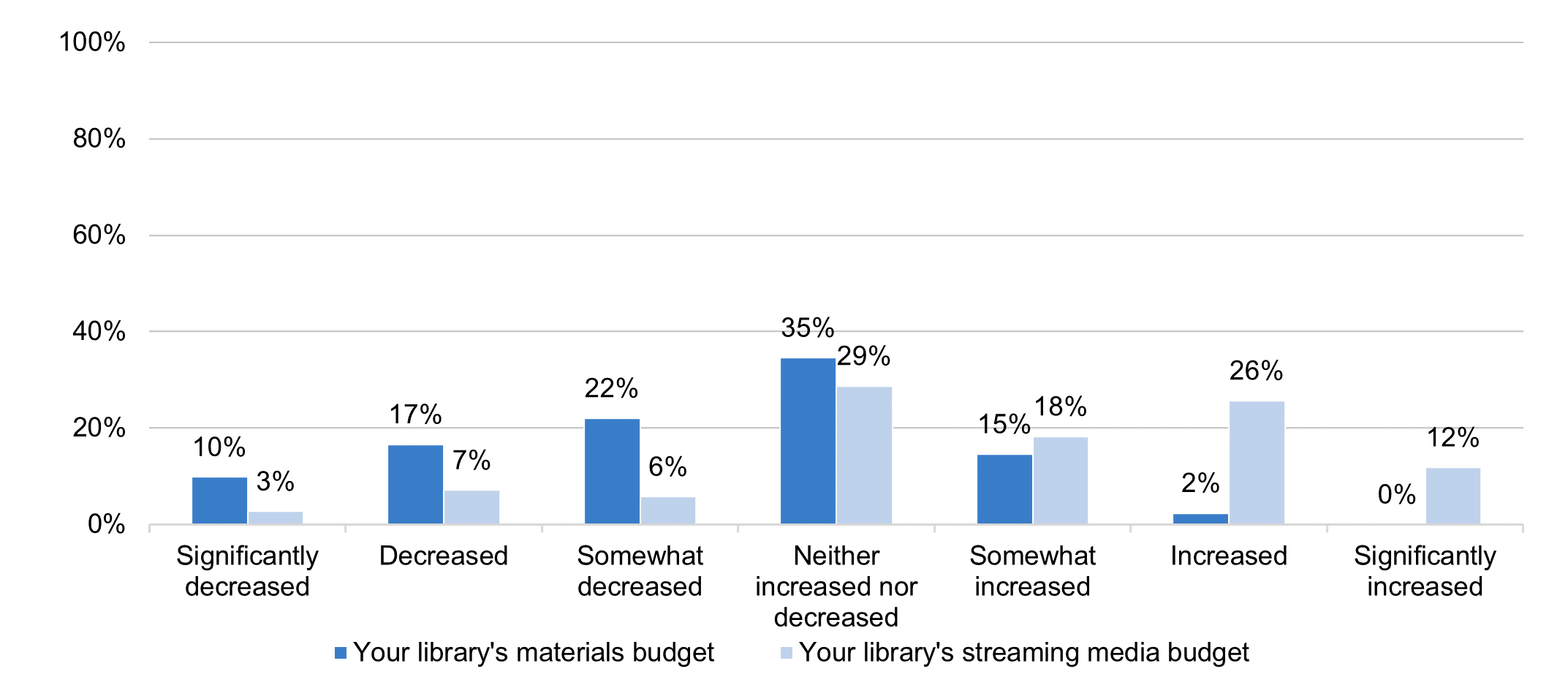
Perhaps as a reflection of the budget and finance environment, very few libraries are interested in making emerging types of streaming media available to library patrons (see Figure 8). In fact, only 3 to 5 percent of libraries are extremely interested in streaming podcasts, conference presentation recordings, augmented and/or virtual reality, or video games. Overwhelmingly, libraries are not at all interested or only slightly interested in making this content available to faculty and students.
Figure 8. How interested are you in making the following emerging streaming media content available to your library patrons?
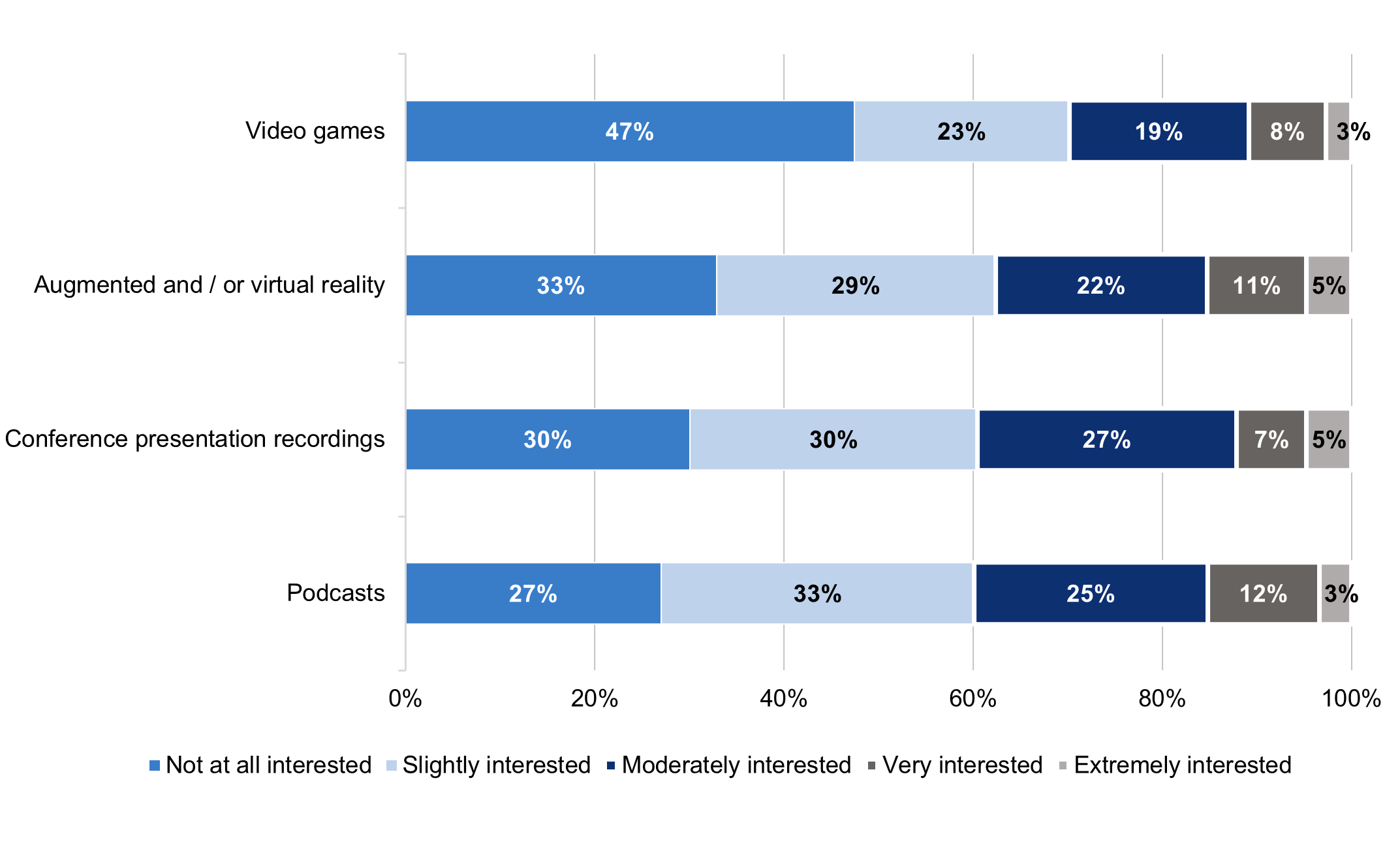
Digitizing physical media such as VHS tapes and/or DVDs plays a relatively small role in meeting streaming media demand.
Most libraries still purchase physical media (86 percent) each year. There are a variety of reasons for this including the cost difference (purchasing physical content is often more cost effective than licensing the same content in its streaming form for a limited period of time for example) and lack of availability for some titles through streaming platforms. As demand for streaming media has increased, libraries have had to manage the role of physical media and, in some cases, determine whether it can be used to help meet the demand for streaming services.
Libraries are relatively evenly split in their practices around digitizing physical media. Forty-six percent of libraries digitize pre-existing, physical VHS tapes and/or DVDs and 49 percent of libraries do not. Most libraries that convert physical media do so on a relatively small scale. Of libraries that digitize VHS tapes and/or DVDs from their pre-existing collections, more than half only digitize between 1 and 10 titles per year, and 72 percent digitize 50 or fewer titles (see Figure 9).
Figure 9. In a typical year, how many pre-existing VHS tapes and/or DVD titles does your library digitize?
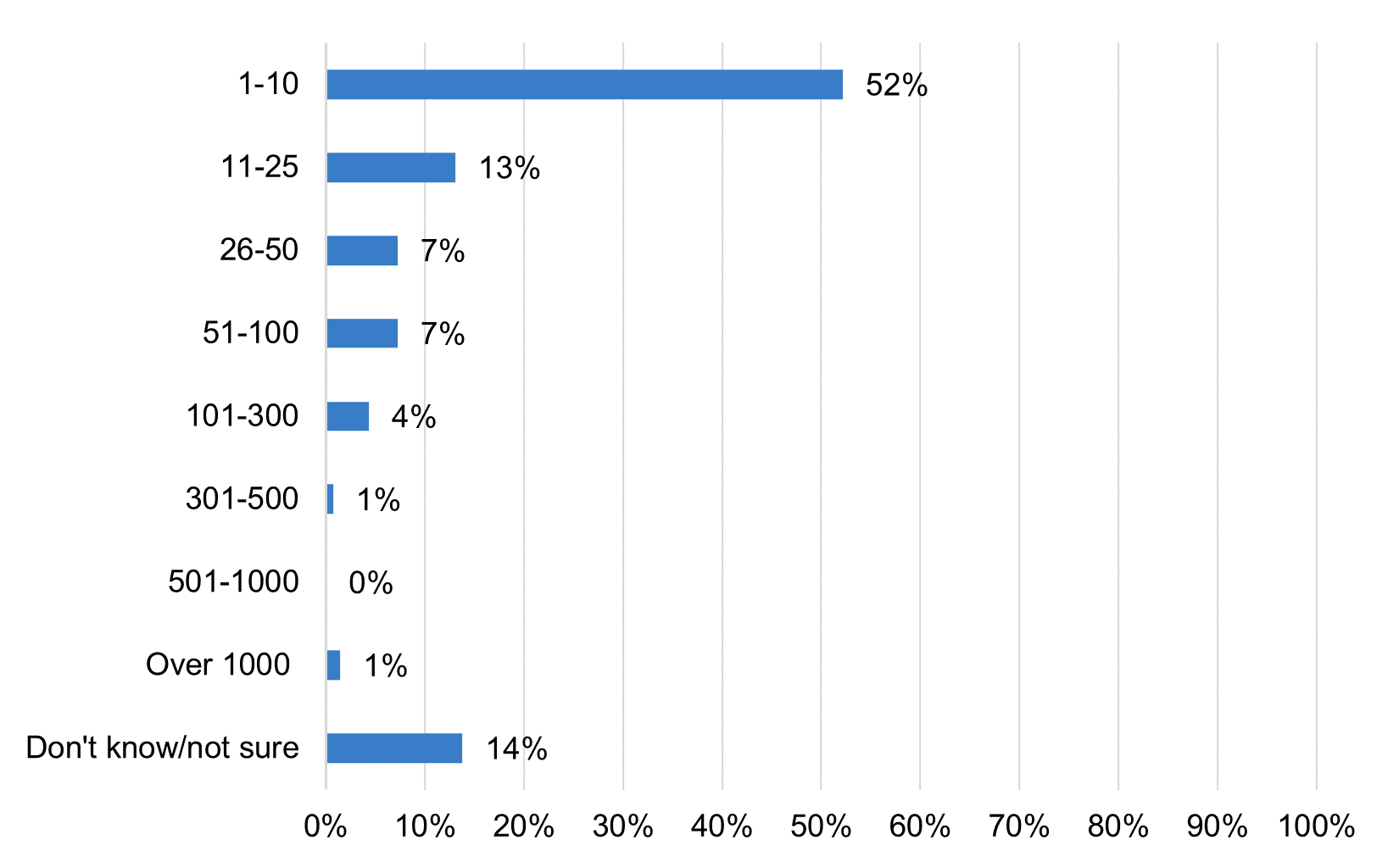
The library collections officer plays an important role here as they are most commonly the person who decides which physical media gets digitized (44 percent) as well as the person responsible for interpreting streaming media copyright regulations and restrictions (43 percent). Library deans and directors (34 percent) and acquisition librarians (26 percent) are also commonly involved in interpreting streaming media copyright guidelines. Interpretation of copyright is a crucial and sometimes complicated task. The majority of respondents to this survey (who hold a range of titles) agree to some extent that they are confident in their ability to interpret copyright regulations and restrictions in regard to streaming media specifically (see Figure 10). However, the majority selected “somewhat agree,” illustrating that additional training or support around interpreting copyright may be warranted.
Figure 10. Please read the following statement and indicate the extent to which you agree or disagree. I am confident in my ability to interpret copyright regulations and restrictions in regards to streaming media specifically.
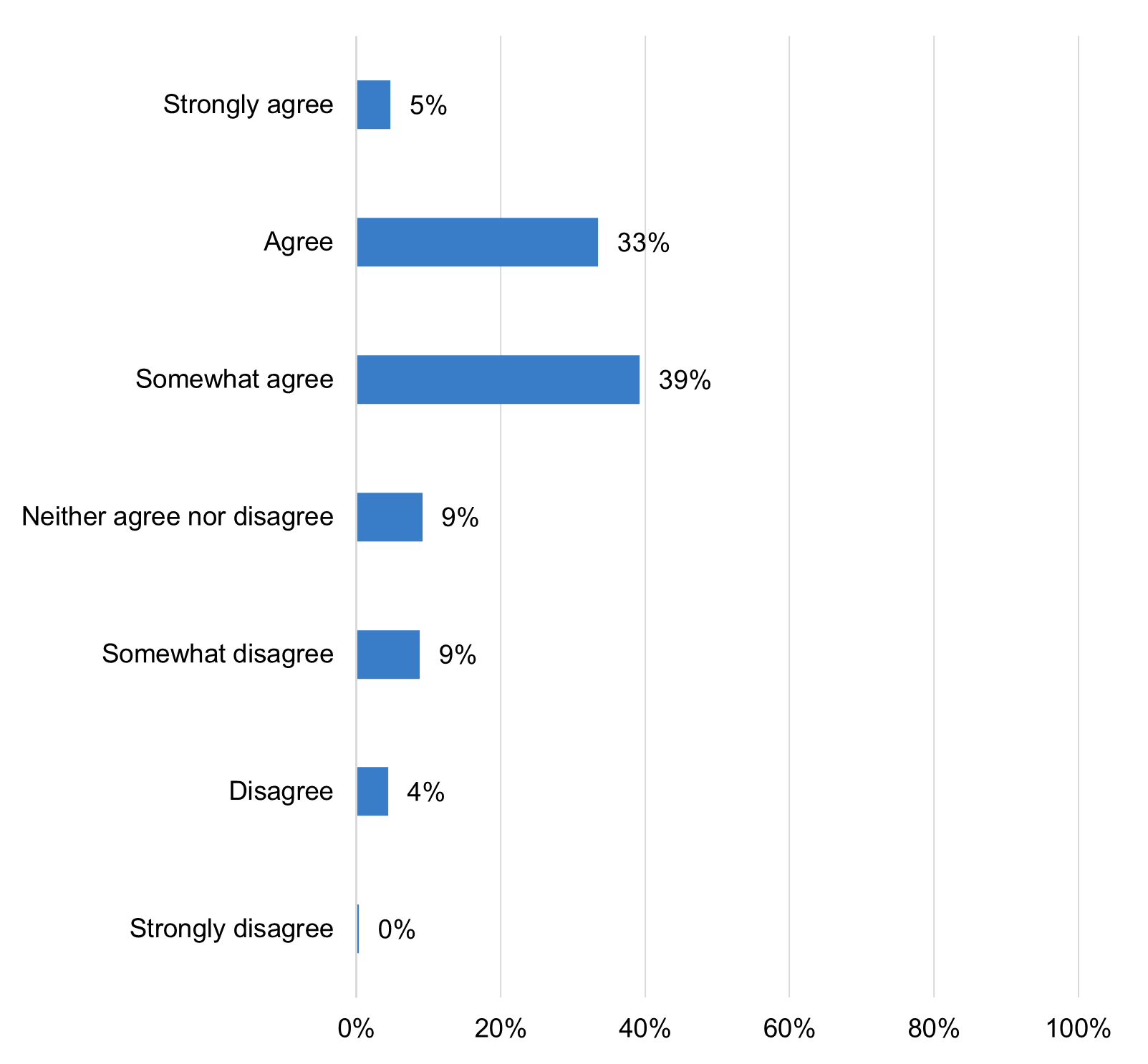
Far and away, when libraries digitize VHS tapes and/or DVDs, they do so through an internal, self-managed system (46 percent). HandBrake (26 percent) and Kaltura (13 percent) are the second and third most common platforms for digitizing content. Once physical media has been digitized, it is most often hosted through an option such as an internal server or learning management system. After self-hosting, Kaltura and Alexander Street are the most used platforms for hosting the digitized media (see Figure 11).
Figure 11. Please indicate which of the following platforms your library uses to digitize and/or host content. Please select all use cases that apply for each platform or select the N/A option to indicate that your library does not use a particular platform.
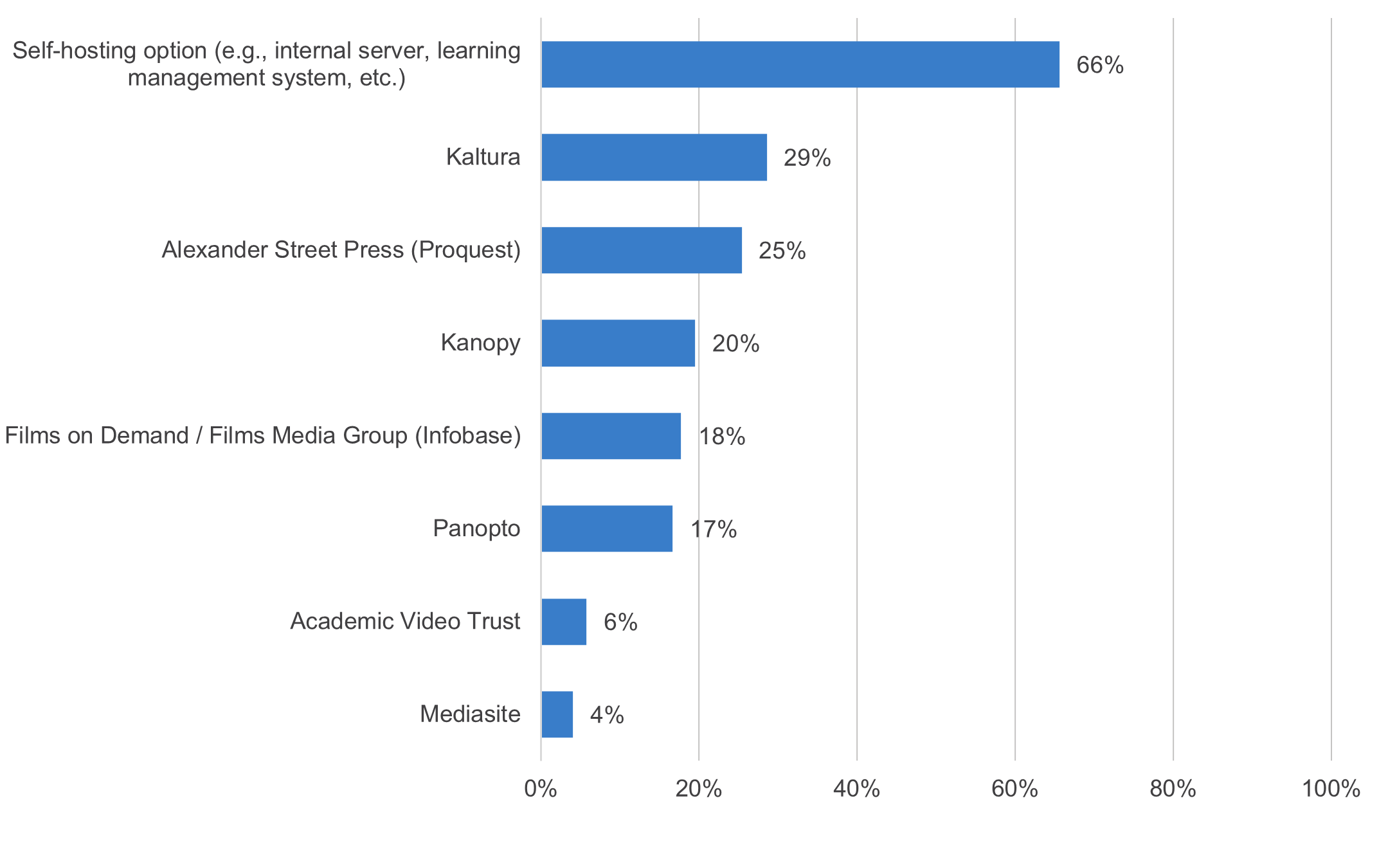
Recognizing National Variations
Given the high degree of variability in streaming media offerings and copyright affordances for digitizing pre-existing content, this study also sought opportunities to explore national variations among libraries. Towards that, the survey captured the perspectives of Canadian institutions by engaging libraries through the Canadian Association of Research Libraries (CARL) consortium. The 24 CARL members were each invited to participate in the Ithaka S+R Streaming Media Survey. Twelve CARL institutions participated, resulting in a 50 percent response rate. While the number of institutions is small, the proportion of the population is significant; given this, the findings provide strong insight into streaming media licensing practices at CARL institutions. Please note that nearly all questions within the survey were optional. This means that while 12 CARL institutions completed the survey, some questions had fewer than 12 responses because not all respondents answered that particular question. All percentages included below are out of the number of respondents who answered the specific question being discussed. Since a small number of respondents can skew percentages by amplifying results (e.g. 50 percent of respondents equates to just 6 people in this sample), we have included the exact number of institutions as well as the percentage to add clarity and context for the reader.
Far and away the most influential factor in shaping CARL librarian decision making in purchasing and renewing streaming licenses is impact on instruction (100 percent; 12 institutions). Instruction and supporting the curriculum is driving purchasing decisions ahead of any other factor, including annual cost (see Figure 12). On the other end of the spectrum, whether streaming services integrated with existing institutional software and/or systems, and flexible payment models were the least influential in driving purchasing decisions.
Figure 12. How important are the following factors in shaping your decision-making in purchasing and renewing streaming licenses? Percentage of respondents at CARL Institutions who rated the following items as important.
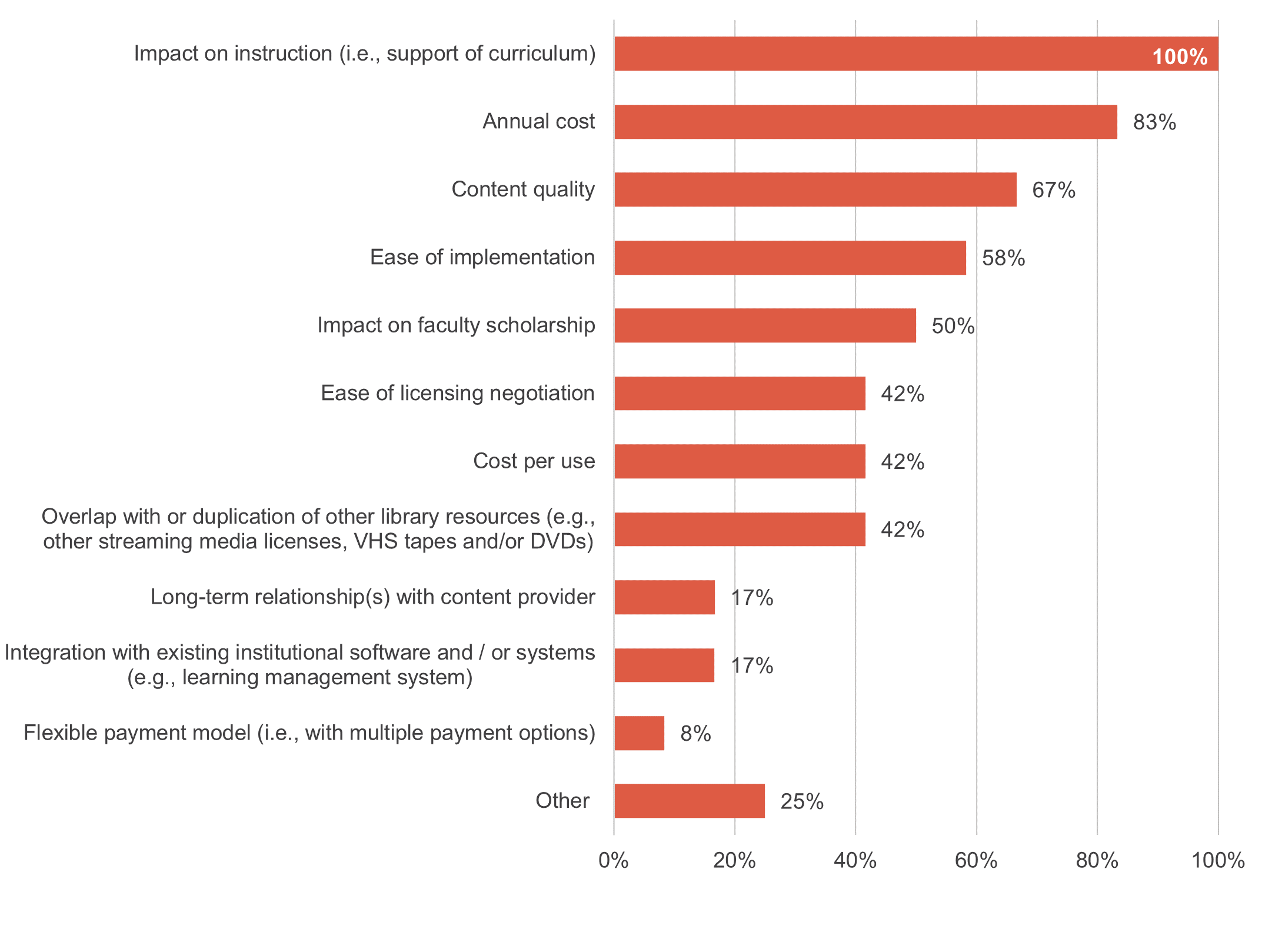
In five years, librarians predict that the proportion of their materials budget dedicated to streaming content will slightly more than double. In the 2021-2022 academic year, the majority (58 percent; seven institutions) of CARL libraries spent 2 percent or less of their materials budget on streaming media (see Figure 13), with the median at 1.75 percent. In five years, that is expected to jump, with the predicted median being 4 percent and only 33 percent (four institutions) spending 2 percent or less of their materials budget on streaming services.
Figure 13. In the 2021-2022 academic year, what percentage of your library’s materials budget is spent on streaming media? And, in five years, what percentage of your library’s materials budget do you estimate will be spent on streaming media?
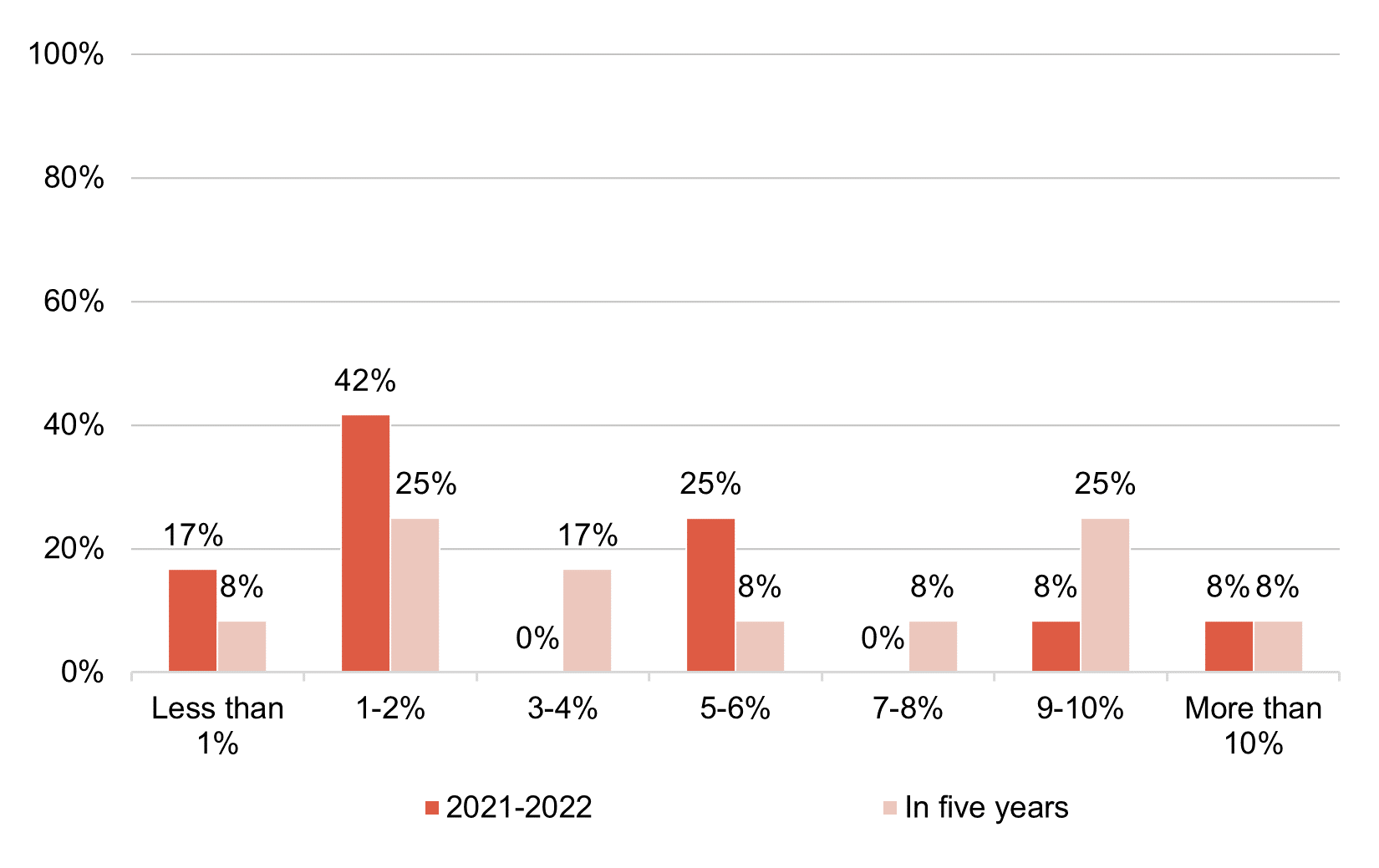
Interestingly, CARL librarians were nearly unanimous in strongly agreeing (92 percent; 11 institutions) that demand for streaming media has increased at their institutions since March 2020 (see Figure 14). Though US four-year institutions and CARL institutions cannot be directly compared due to the population size difference between the two, it is worth noting that only 42 percent of US institutions strongly agreed that streaming media demand increased since March 2020. There are several possible explanations for this difference. One explanation is that until the relatively recent addition of the 2012 “fair dealing” provision in Canada, which allows instructors to show streaming clips in class without public performance rights, Canadian instructors were not allowed to extract clips or show short portions of films without public performance rights. In contrast, US instructors have traditionally had more robust and long-standing exemptions for clips for remote instruction through the TEACH Act. Another possible explanation is that Canadian libraries may have not had as robust streaming offerings pre-pandemic as US libraries and so demand for streaming media accelerated more rapidly since March 2020. A third explanation is that Canadian libraries had comparatively fewer streaming options available to them pre-pandemic and as more streaming options became available as a result of COVID-19, libraries were able to seize this opportunity. Finally, in many Canadian jurisdictions, COVID-19 policies were stricter than at US institutions, resulting in students learning remotely for a longer period of time, which likely would have further increased demand for streaming services.
Figure 14. Please read the following statement and indicate the extent to which you agree or disagree. Demand for streaming media has increased at my institution since March 2020.
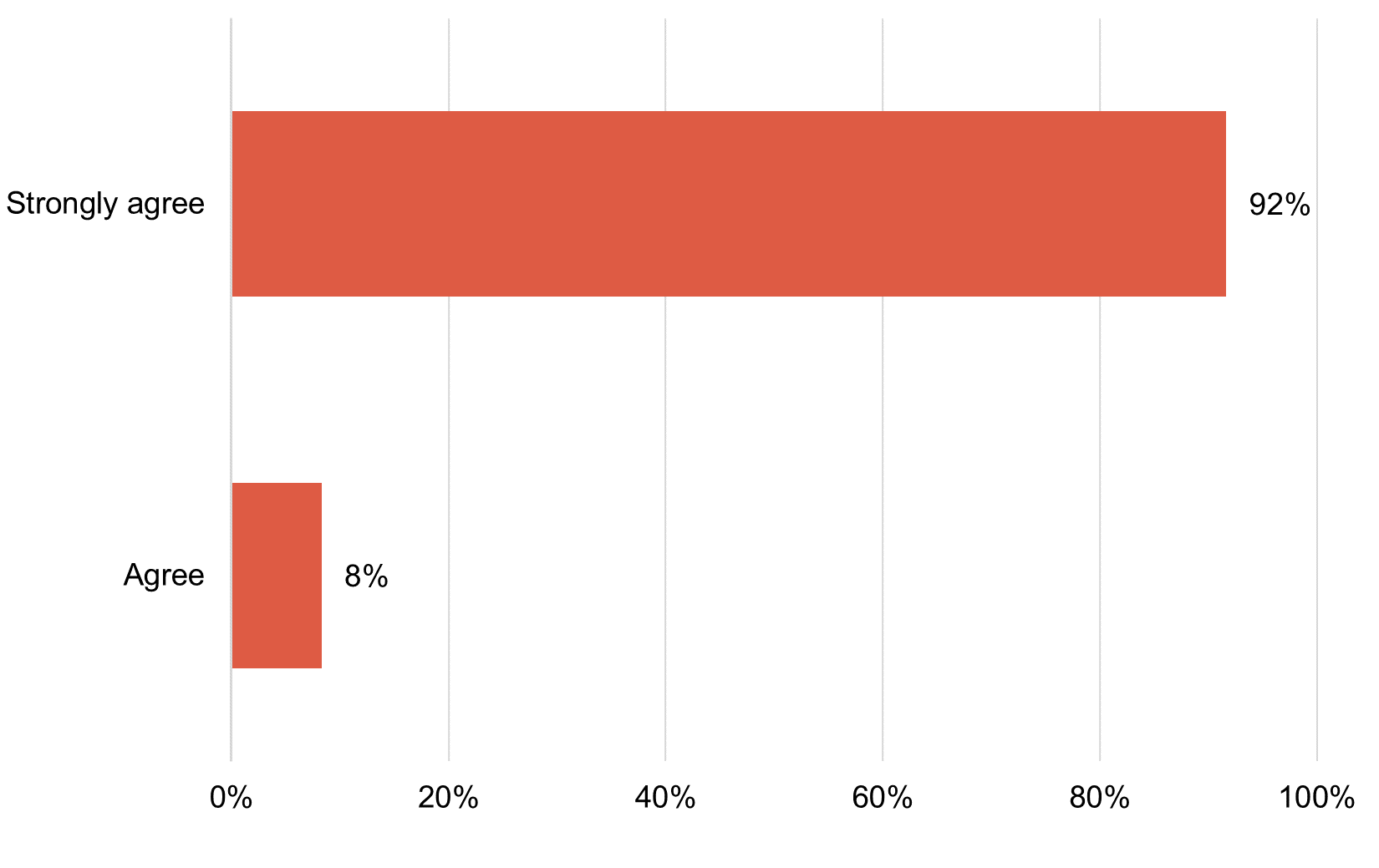
Note: All respondents selected “Agree” or “Strongly Agree” in answer to this question.
Implications for Libraries and Vendors
Our research into streaming media procurement practices demonstrates that libraries are doubling down on teaching and learning priorities in an era otherwise defined by resource constraint. As our results make clear, impact on instruction is the top factor libraries consider when making purchasing decisions related to streaming media. The importance of this resource type to meeting student needs increased during the pandemic and seems poised to continue to grow in coming years. If the projections from the survey hold true, spending on streaming media will increase in tandem with decreased spending on other materials. As a result, streaming media will be increasingly central to the library’s investment in instruction.
As streaming costs consume a greater share of the library’s investment portfolio, it will be imperative for the library to effectively communicate how this expense aligns with the university’s core mission of educating students. This will involve demonstrating the pedagogical value of specific streaming media resources by investing sufficient staff capacity to track usage, exploring evolving pedagogical needs, and developing robust relationships with instructors whose instructional practices benefit from those materials. For some libraries, there may be opportunities to use savings from moving to OERs to subsidize future investments in streaming media. Library decision makers contemplating this approach will need to consider how the affordances of the library’s strategy towards openness, such as through canceling journal subscriptions and/or replacing textbooks with OERs helped their institution arrive at this moment of critical budgetary realignment.
Increasing their already considerable investments in instructional materials is not without challenges for libraries. The survey findings suggest that it is difficult for libraries to fully realize the value of already purchased VHS and DVD collections due to low rates of digitization. In the US, capacity and copyright are likely the major barriers to libraries creating more expansive digitization programs to facilitate broader access to these collections within and between institutions. Given the relatively low representation of OERs among streaming media content the library engages with, it is also unclear how much latitude libraries have to bring streaming media into alignment with OER strategies although partnerships between institutions and educational distributors, similar to the Academic Library Video Trust initiative, may offer models for aligning OER initiatives with streaming media. However, as long as the policy landscape continues to allow educational pricing that so closely mirrors the direct-to-consumer model in the entertainment sector, it is unlikely that much progress can be made for streaming-related OER initiatives.
Vendors looking to create or expand streaming media offerings will likewise benefit from careful consideration of the close connection between libraries’ streaming purchasing and teaching and learning. In the US demand for streaming media during the pandemic may have increased, but library purchasing strategies remained relatively stable, as libraries took a more conservative, “just in time” approach to licensing that prioritized immediate and demonstrated instructional needs. The shift by some institutions from unmediated to mediated acquisition models in conjunction with the low volume of VHS and DVDs being digitized suggests that meeting instructor requests for content is perceived as essential to university operations, whereas serendipitous discovery of new video content by students or researchers is not.
The continued market dominance of Kanopy and Alexander Street documented in the survey reflects the status of feature films and documentaries as the most “instruction critical” category of streaming media available for libraries to purchase. This positioning is incredibly valuable, and is an important factor in recent consolidation trends, with Kanopy being acquired by OverDrive and ProQuest being acquired by Clarivate.[6] Unless mainstream media companies in the US become more amenable to educational licensing to third parties, there will be limited opportunities for new vendors to enter this market. However, there may be opportunities for other kinds of video content, such as instructional videos. The forthcoming companion research to this survey, which will feature the perspectives of instructors in a variety of fields, will further explore instructional practices with video content other than feature film and documentary.
Vendors seeking growth opportunities in the academic streaming media market will need to clearly align their offerings with present teaching and learning needs.
Regardless of genre, vendors seeking growth opportunities in the academic streaming media market will need to clearly align their offerings with present teaching and learning needs. This is especially important for the start-ups, societies, and other entities seeking to package scholarly communications in streaming media formats. Vendors should consider the following questions about these potential offerings[7] What essential pedagogical value can be derived from the product? And how are these streaming media materials different from the trends in the market for textbooks, where purchasing responsibility, traditionally delegated primarily to the student, which the OER and low-cost textbook movements are seeking to disrupt?
Our findings ultimately suggest that neither libraries nor vendors have fully realized the opportunities for integrating streaming within the teaching and learning space of higher education.
Our findings ultimately suggest that neither libraries nor vendors have fully realized the opportunities for integrating streaming within the teaching and learning space of higher education. About half of US libraries are making decisions for streaming purchasing and licensing based on LMS integration capabilities, and when digitizing pre-existing VHS and DVD collections, nearly half also choose to make that content available through self-hosting options including the LMS. A combination of factors likely contribute to the high usage of self-hosting, including the ability to limit access to certain classes, the difficulty of cataloging streaming content in discovery platforms, and legal considerations. Some streaming media vendors are offering hosting services opportunistically for current customers, with the survey findings suggesting that about a quarter of customers with the top three providers are electing to use this service. Given the instability of cloud storage costs and the current preference for self-hosting solutions it is unclear how much of an opportunity there is for streaming media providers to further build out their hosting solutions.
However, when looking to the future, it is important to recognize that instructors are recording and making their own instructional content (especially lectures) more often than in previous years, partially due to shifting student expectations that course materials will be available on-demand. These expectations will likely continue even as in-person instruction returns to pre-pandemic levels. These evolving pedagogical practices and needs pulls the center of instructional gravity further into the LMS and creates new possibilities for licensing content both for maximizing the value of locally produced outputs and finding efficiencies by using content produced elsewhere. In this context the long-term question becomes properly assessing what proportion of essential pedagogical materials will the library provide as streaming media dominates higher learning in new ways?
Appendix 1
Ithaka S+R thanks the 24 university libraries and their research teams for collaborating on the Streaming Media project, which enabled the survey reported on here to be conducted and the resulting findings to be made public for wider benefit to the community-at-large:
- Brigham Young University: Emily Darowski, Betsy Hopkins, Elizabeth Smart, Rebecca Walton
- California State University Fullerton: Anthony Davis, Kevin Phillips, Keri Prelitz, Ann Roll
- Central Washington University: Nicole Cabral, Bridgette Flamenco, Erin Sulla, Sydney Thompson
- Davidson College: Matt Ballard, Lisa Forrest
- Freie Universität Berlin: Franziska Harnisch, Julian Katz, Mario Kowalek, Sina Menzel, Lea Schneider, Cosima Wagner
- Georgetown University: Emily Guhde, Melissa Jones, Mark Winek
- Harvard University: Jessica Evans Brady, Reed Lowrie, Joshua Lupkin, Nicole Santiago
- Haverford College: Anna Fodde-Reguer, Ellen Garrison, Norm Medeiros
- Johns Hopkins University: Don Juedes, Jessica Keyes, Liz Mengel, Mariyam Thohira
- North Carolina State University: Emily Cox, Xiaoyan Song, Lynn Whittenberger
- Ohio State University: Anita Foster, Courtney Hunt, Jennifer Schnabel, Gene Springs
- Portland State University: Carly Lamphere, Elsa Loftis
- San Jose State University: Ann Agee, Emily Chan, Mantra Roy, Nick Szydlowski
- Sewanee: The University of the South: Penny Cowan, Pat Dover
- University of British Columbia: Lisa Larkins, Arielle Lomness, Anne Olsen, Sarah Parker
- University of Connecticut: Susanna Cowan, Roxanne Peck, Michael Rodriguez, Jane Strudwick, Merlita Taitague
- University of Delaware: Maria Barefoot, Erin Daix, Meghann Matwichuk
- University of Manitoba: Victoria Ho, Leslie Moor, Alex Snukal, Jennifer Ticknor
- University of Maryland: Daniel Mack
- University of Michigan: Laurie Alexander, Sigrid Anderson, Kristen Castellana, Shevon Desai
- University of Pittsburgh: Fern Brody, Katherine Collins, Peter Egler, Christopher Lemery
- University of Virginia: Beth Blanton-Kent, Timothy Morton, Arlyn Newcomb, Erin Pappas, Elizabeth Rapp, Leigh Rockey
- University of Wyoming: Kaijsa Calkins, Paula Martin, Debbie McCarthy, Denis Shannon, Jennifer Strayer
- Wayne State University: Paul Beavers, Veronica Bielat, Rachael Clark, Carly Lesoski, Serena Vaquilar
Appendix 2
Ithaka S+R thanks the 11 library stakeholders with expertise in streaming media for helping to test the survey instrument through a cognitive interviewing process.
- Nancy Friedland, Columbia University
- Megan Heady, West Virginia University
- Katie Lynn, Kansas State University
- Anne Mitchell, University of Texas at San Antonio
- Laura Ponikvar, Cleveland Institute of Art
- Sarah Stevenson, Dalhousie University
- Gisèle Tanasse, University of California, Berkeley
- Shannon Tharp, University of Denver
- Katy Tucker, Xavier University
- Nicole Wood, Austin Peay State University
- Arleen Zimmerle, Bryn Mawr College
Appendix 3
The survey was administered through direct invitation to 1,493 individuals responsible for collections management and development decisions at public and private not-for-profit four-year college and university libraries. Of the 1,493 individuals we attempted to contact, five emails bounced or failed, bringing the total number of invited individuals to 1,488. The titles of persons responsible for streaming media purchasing and licensing varied by institution, but included library directors, heads of acquisitions, university librarians, and collection development librarians, among others. One individual per institution received the invitation. The majority of respondents represent institutions in the United States, and a select sample represents institutions located in Canada. The survey launched on October 21, 2021, and closed on December 9, 2021. Four reminder emails were sent in addition to the initial invitation. In order to increase participation from CARL institutions, we made the decision to resend the Streaming Media Survey solely to CARL institutions on January 4, 2022, and closed the survey on February 3, 2022.
Ultimately, we received 309 completed surveys, resulting in a 21 percent response rate for the overall sample. Of this sample, we received 297 completed surveys from US institutions (20 percent response rate) and 12 completed surveys from Canadian institutions (50 percent response rate). We analyzed the data using a combination of descriptive and statistical analyses. This included examining frequencies, one-way ANOVA with the Scheffe post-hoc test, Pearson’s chi-square, and Fisher’s exact test. The results of these analyses included in this research report are statistically significant at the p<.05 level. When discussing scale frequencies throughout this report, we combine responses at the high and low end of the scales unless otherwise specified. For example, for questions with seven-point scales, we include the top two response options to indicate agreement and the bottom two response options to indicate disagreement.
Our analysis benefited from preliminary feedback from the team leads among the 24 libraries that partnered with Ithaka S+R on the study, as well as thoughtful review of the resulting written draft by Joe Esposito, Kimberly Lutz, Roger Schonfeld, and Gisèle Tanasse.
Appendix 4
| Population Demographic | Frequency | Percentage |
| Carnegie Classification – US | ||
| Baccalaureate Colleges | 71 | 24.65% |
| Master’s Colleges & Universities | 102 | 35.42% |
| Doctoral Universities | 115 | 39.93% |
| Current Role – US and Canada[8] | ||
| Entry-level or Mid-level individual contributor | 28 | 9.06% |
| Senior-level individual contributor | 26 | 8.41% |
| Manager/supervisor | 134 | 43.37% |
| Senior administrator | 105 | 33.98% |
| I prefer not to answer this question | 16 | 5.18% |
Endnotes
- Most notably, the collective action of the Library Freedom Project and Library Futures recently drew attention to content widely available on Hoopla and Overdrive intended to “promote an ideology of hate,” see Library Freedom Project and Library Futures, “We Demand Accountability from Hoopla Digital and Overdrive Regarding the Platforming of Fascist Propaganda in their Digital Library Collections,” Medium, 22 February 2022), https://libraryfreedom.medium.com/we-demand-accountability-from-hoopla-digital-and-overdrive-regarding-the-platforming-of-fascist-c47c88e62ddc. ↑
- Gisèle Tanasse, “Implementing and Managing Streaming Media Services in Academic Libraries,” Choice White Paper, no. 8, 28 June 2021, https://www.choice360.org/research/implementing-and-managing-streaming-media-services-in-academic-libraries/; Cara M. Barker, Whitney P. Jordan, and Jessica H. Zellers, “Starting a Streaming Video Program on a Limited Budget,” in What’s Past Is Prologue: Charleston Conference Proceedings 2017, eds. Katina P. Strauch et al. (Purdue University Press, 2018), 211–15, https://www.jstor.org/stable/j.ctv15wxrp9.48; Christian Lear, “Controlled Digital Lending of Video Resources: Ensuring the Provision of Streaming Access to Videos for Pedagogical Purposes in Academic Libraries,” Journal of Copyright in Education & Librarianship 5, no. 1 (2021), https://doi.org/10.17161/jcel.v5i1.14807; Jennifer A. Dixon, “The Academic Mainstream | Streaming Video,” Library Journal, 7 September 2017, https://www.libraryjournal.com?detailStory=academic-mainstream-streaming-video; Kerry A. Falloon, “Rolling with PDA and DDA: How Academic Libraries Can Use Patron-Driven and Demand-Driven Acquisition Techniques to Build Library Collections With Minimal Management and Budget,” in Roll with the Times, or the Times Roll Over You: Charleston Conference Proceedings 2016, eds. Beth R. Bernhardt et al. (Purdue University Press, 2017), 267–71, https://www.jstor.org/stable/j.ctvhhhdbh.51; Andrea Rodgers, “Once upon a Time in Streaming Video: A Community College’s Adventure with Kanopy’s PDA Model, College & Research Libraries News 80, no. 9 (2019), https://doi.org/10.5860/crln.80.8.498; Amanda A. Grombly, “Streaming Video Acquisition Models for Small to Medium Academic Libraries,” The Serials Librarian 79, nos. 1-2 (2020) https://doi.org/10.1080/0361526X.2020.1772169; Randall A. Lowe et al., “Managing Streaming Video: The Experiences of Six Academic Libraries,” Journal of Electronic Resources Librarianship 32, no. 2 (2020): 119–26, https://doi.org/10.1080/1941126X.2020.1739831. ↑
-
The name “Alexander Street Press (ProQuest),” which was used in the survey instrument, has since changed to “Alexander Street.” This name change took place after the survey was in the field when Clarivate purchased ProQuest in December 2021.
- The turn away from unmediated access had already begun prior to the pandemic at both public and university libraries. See Chris Cagle, “Kanopy: Not Just Like Netflix, and Not Free,” Film Quarterly, 3 May 2019, https://filmquarterly.org/2019/05/03/kanopy-not-just-like-netflix-and-not-free/; Christian Lear, “Controlled Digital Lending of Video Resources: Ensuring the Provision of Streaming Access to Videos for Pedagogical Purposes in Academic Libraries,” Journal of Copyright in Education & Librarianship 5, no. 1 (2021), https://doi.org/10.17161/jcel.v5i1.14807; Chris O’Falt, “As Kanopy’s Popularity Grows, Can Your Library Continue to Afford It?,” IndieWire (blog), 26 June 2019, https://www.indiewire.com/2019/06/new-york-public-library-drops-kanopy-netflix-alternative-too-expensive-1202153550/; Barbara Fister, “Unkind Rewind,” Inside Higher Ed, 26 June 2019, https://www.insidehighered.com/blogs/library-babel-fish/unkind-rewind; Dylan Burns, “‘Wait a Minute Honey, I’m Gonna Add It up:’ Kanopies, DRM, and the Permanence of the Collection,” ACRLog (blog), 8 July 2019, https://acrlog.org/2019/07/08/wait-a-minute-honey-im-gonna-add-it-up-kanopies-drm-and-the-permanence-of-the-collection/; Sandra Gall Urban, “Evaluating Kanopy Access Models in Academic Libraries: Balancing Demand and Budget Constraints,” Collection Management 47, no. 1 (2021), https://doi.org/10.1080/01462679.2021.1940410. ↑
- Jennifer K. Frederick and Christine Wolff-Eisenberg, “Academic Library Strategy and Budgeting During the COVID-19 Pandemic: Results from the Ithaka S+R US Library Survey 2020,” Ithaka S+R, 9 December 2020, https://sr.ithaka.org/publications/academic-library-strategy-and-budgeting-during-the-covid-19-pandemic/. ↑
- For more on the market implications of these acquisitions for the academic streaming media market, see Danielle Cooper and Roger C. Schonfeld, “A Media Empire for the (Public) Library?” The Scholarly Kitchen, 15 June 2021, https://scholarlykitchen.sspnet.org/2021/06/15/overdrive-kanopy/. ↑
- For an overview, see Danielle Cooper and Dylan Ruediger, “Event Streaming Start-Ups: A Strategic Overview and Taxonomy,” The Scholarly Kitchen, 20 April 2022, https://scholarlykitchen.sspnet.org/2022/04/20/guest-post-event-streaming-start-ups-a-strategic-overview-and-taxonomy/. ↑
- The US and Canadian samples are included in the aggregate because the n for Canadian respondents is too small to disaggregate. ↑
